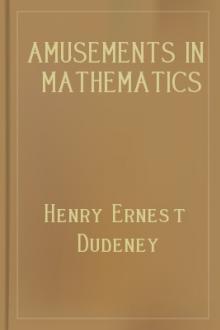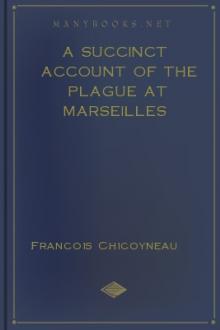Amusements in Mathematics, Henry Ernest Dudeney [books to read to be successful txt] 📗

- Author: Henry Ernest Dudeney
- Performer: 0486204731
Book online «Amusements in Mathematics, Henry Ernest Dudeney [books to read to be successful txt] 📗». Author Henry Ernest Dudeney

This is the exact position of the rings after the 9,999th move has been made, and the reader will find that the method shown will solve any similar question, no matter how many rings are on the tiring-irons. But in working the inverse process, where you are required to ascertain the number of moves necessary in order to reach a given position of the rings, the rule will require a little modification, because it does not necessarily follow that the position is one that is actually reached in course of taking off all the rings on the irons, as the reader will presently see. I will here state that where the total number of rings is odd the number of moves required to take them all off is one-third of (2(n + 1) - 1).
With n rings (where n is odd) there are 2n positions counting all on and all off. In 1/3 (2(n+1) + 2) positions they are all removed. The number of positions not used is (1/3)(2n - 2).
With n rings (where n is even) there are 2n positions counting all on and all off. In (2(n + 1) + 1) positions they are all removed. The number of positions not used is here (1/3)(2n - 1).
It will be convenient to tabulate a few cases.
Rings. Total
Positions. Positions
used. Positions
not used. 1 2 2 0 3 8 6 2 5 32 22 10 7 128 86 42 9 512 342 170 2 4 3 1 4 16 11 5 6 64 43 21 8 256 171 85 10 1024 683 341
Note first that the number of positions used is one more than the number of moves required to take all the rings off, because we are including "all on" which is a position but not a move. Then note that the number of positions not used is the same as the number of moves used to take off a set that has one ring fewer. For example, it takes 85 moves to remove 7 rings, and the 42 positions not used are exactly the number of moves required to take off a set of 6 rings. The fact is that if there are 7 rings and you take off the first 6, and then wish to remove the 7th ring, there is no course open to you but to reverse all those 42 moves that never ought to have been made. In other words, you must replace all the 7 rings on the loop and start afresh! You ought first to have taken off 5 rings, to do which you should have taken off 3 rings, and previously to that 1 ring. To take off 6 you first remove 2 and then 4 rings.
418.—SUCH A GETTING UPSTAIRS.—solution
Number the treads in regular order upwards, 1 to 8. Then proceed as follows: 1 (step back to floor), 1, 2, 3 (2), 3, 4, 5 (4), 5, 6, 7 (6), 7, 8, landing (8), landing. The steps in brackets are taken in a backward direction. It will thus be seen that by returning to the floor after the first step, and then always going three steps forward for one step backward, we perform the required feat in nineteen steps.
419.—THE FIVE PENNIES.—solution

First lay three of the pennies in the way shown in Fig. 1. Now hold the remaining two pennies in the position shown in Fig. 2, so that they touch one another at the top, and at the base are in contact with the three horizontally placed coins. Then the five pennies will be equidistant, for every penny will touch every other penny.
420.—THE INDUSTRIOUS BOOKWORM.—solution
The hasty reader will assume that the bookworm, in boring from the first to the last page of a book in three volumes, standing in their proper order on the shelves, has to go through all three volumes and four covers. This, in our case, would mean a distance of 9½ in., which is a long way from the correct answer. You will find, on examining any three consecutive volumes on your shelves, that the first page of Vol. I. and the last page of Vol. III. are actually the pages that are nearest to Vol. II., so that the worm would only have to penetrate four covers (together, ½ in.) and the leaves in the second volume (3 in.), or a distance of 3½ inches, in order to tunnel from the first page to the last.
421.—A CHAIN PUZZLE.—solution
To open and rejoin a link costs threepence. Therefore to join the nine pieces into an endless chain would cost 2s. 3d., whereas a new chain would cost 2s. 2d. But if we break up the piece of eight links, these eight will join together the remaining eight pieces at a cost of 2s. But there is a subtle way of even improving on this. Break up the two pieces containing three and four links respectively, and these seven will join together the remaining seven pieces at a cost of only 1s. 9d.
422.—THE SABBATH PUZZLE.—solution
The way the author of the old poser proposed to solve the difficulty was as follows: From the Jew's abode let the Christian and the Turk set out on a tour round the globe, the Christian going due east and the Turk due west. Readers of Edgar Allan Poe's story, Three Sundays in a Week, or of Jules Verne's Round the World in Eighty Days, will know that such a proceeding will result in the Christian's gaining a day and in the Turk's losing a day, so that when they meet again at the house of the Jew their reckoning will agree with his, and all three may keep their Sabbath on the same day. The correctness of this answer, of course, depends on the popular notion as to the definition of a day—the average duration between successive sun-rises. It is an old quibble, and quite sound enough for puzzle purposes. Strictly speaking, the two travellers ought to change their reckonings on passing the 180th meridian; otherwise we have to admit that at the North or South Pole there would only be one Sabbath in seven years.
423.—THE RUBY BROOCH.—solution
In this case we were shown a sketch of the brooch exactly as it appeared after the four rubies had been stolen from it. The reader was asked to show the positions from which the stones "may have been taken;" for it is not possible to show precisely how the gems were originally placed, because there are many such ways. But an important point was the statement by Lady Littlewood's brother: "I know the brooch well. It originally contained forty-five stones, and there are now only forty-one. Somebody has stolen four rubies, and then reset as small a number as possible in such a way that there shall always be eight stones in any of the directions you have mentioned."

The diagram shows the arrangement before the robbery. It will be seen that it was only necessary to reset one ruby—the one in the centre. Any solution involving the resetting of more than one stone is not in accordance with the brother's statement, and must therefore be wrong. The original arrangement was, of course, a little unsymmetrical, and for this reason the brooch was described as "rather eccentric."
424.—THE DOVETAILED BLOCK.—solution

The mystery is made clear by the illustration. It will be seen at once how the two pieces slide together in a diagonal direction.
425.—JACK AND THE BEANSTALK.—solution
The serious blunder that the artist made in this drawing was in depicting the tendrils of

the bean climbing spirally as at A above, whereas the French bean, or scarlet runner, the variety clearly selected by the artist in the absence of any authoritative information on the point, always climbs as shown at B. Very few seem to be aware of this curious little fact. Though the bean always insists on a sinistrorsal growth, as B, the hop prefers to climb in a dextrorsal manner, as A. Why, is one of the mysteries that Nature has not yet unfolded.
426.—THE HYMN-BOARD POSER.—solution
This puzzle is not nearly so easy as it looks at first sight. It was required to find the smallest possible number of plates that would be necessary to form a set for three hymn-boards, each of which would show the five hymns sung at any particular service, and then to discover the lowest possible cost for the same. The hymn-book contains 700 hymns, and therefore no higher number than 700 could possibly be needed.
Now, as we are required to use every legitimate and practical method of economy, it should at once occur to us that the plates must be painted on both sides; indeed, this is such a common practice in cases of this kind that it would readily occur to most solvers. We should also remember that some of the figures may possibly be reversed to form other figures; but as we were given a sketch of the actual shapes of these figures when painted on the plates, it would be seen that though the 6's may be turned upside down to make 9's, none of the other figures can be so treated.
It will be found that in the case of the figures 1, 2, 3, 4, and 5, thirty-three of each will be required in order to provide for every possible emergency; in the case of 7, 8, and 0, we can only need thirty of each; while in the case of the figure 6 (which may be reversed for the figure 9) it is necessary to provide exactly forty-two.
It is therefore clear that the total number of figures necessary is 297; but as the figures are painted on both sides of the plates, only 149 such plates are required. At first it would appear as if one of the plates need only have a number on one side, the other side being left blank. But here we come to a rather subtle point in the problem.
Readers may have remarked that in real life it is sometimes cheaper when making a purchase to buy more articles than we require, on the principle of a reduction on taking a quantity: we get more articles and we pay less. Thus, if we want to buy ten apples, and the price asked is a penny each if bought singly, or ninepence a dozen, we should both save a penny and get two apples more than we wanted by buying the full twelve. In the same way, since there is a regular scale of reduction for plates painted alike, we actually save by having two figures painted on that odd plate. Supposing, for example, that we have thirty plates painted alike with 5 on one side and 6 on the other. The rate would be 4¾d., and the cost 11s. 10½d. But if the odd plate with, say, only a 5 on one side of it have





Comments (0)